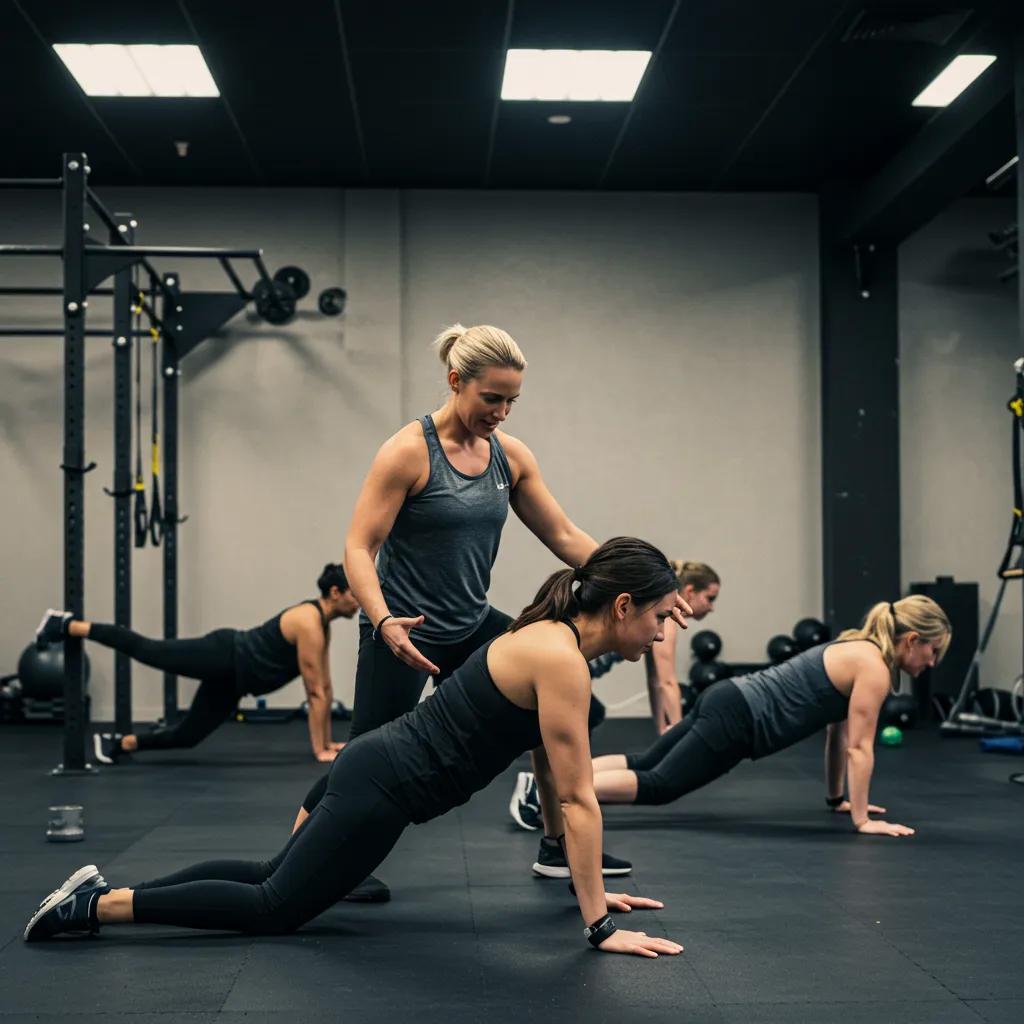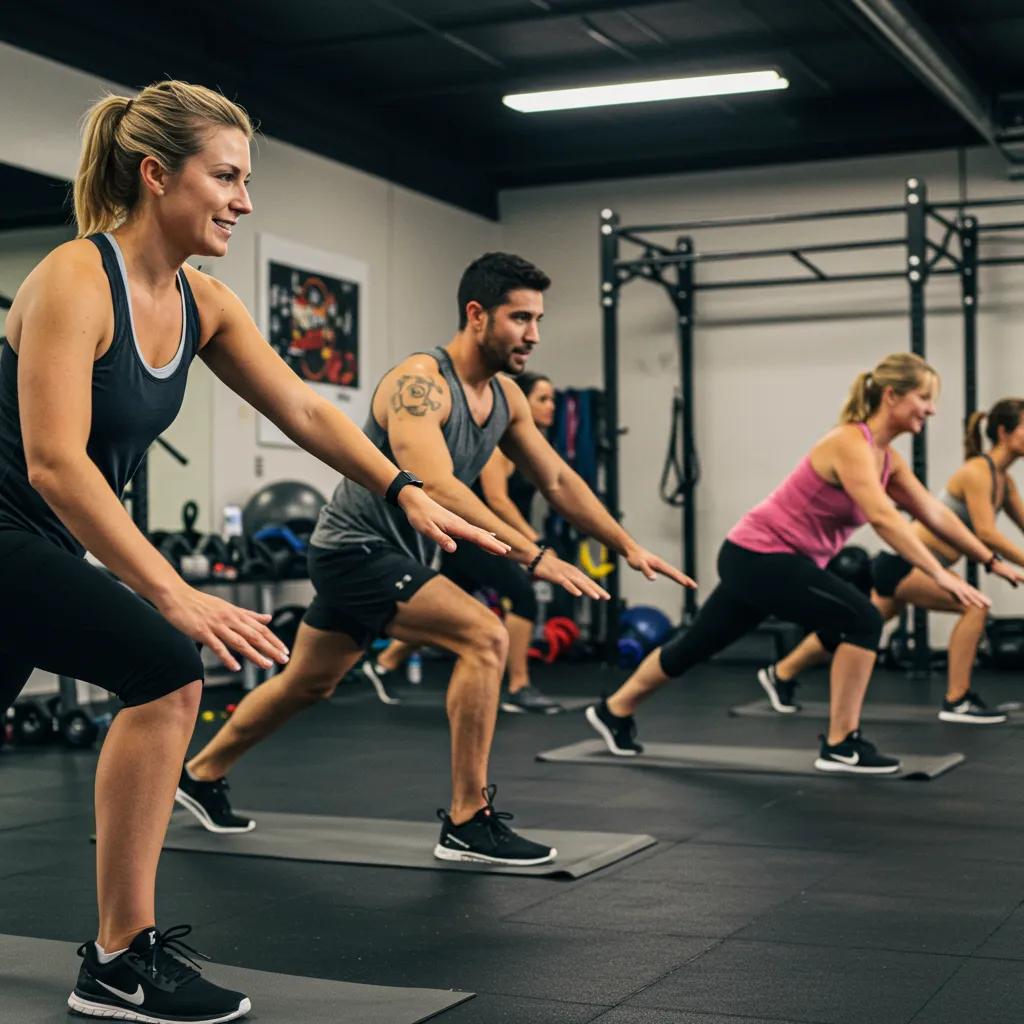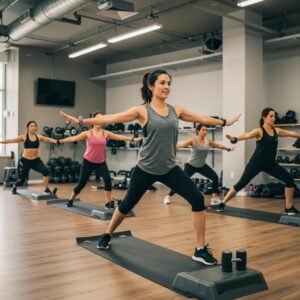Small group workout classes combine focused coaching with social dynamics to produce faster fitness results than many solo or large-class approaches. In Newtown, these classes blend personalized trainer feedback, structured progressive programming, and peer-driven accountability to accelerate strength, endurance, and body-composition changes. Readers will learn why small-group formats speed progress, which class types best match common goals, how nutrition coaching amplifies outcomes, the role of certified trainers, and real local success patterns. Many people struggle with inconsistent attendance, poorly scaled workouts, and mismatched nutrition; small-group training solves these by delivering hands-on correction, scheduled commitment, and community-based habit support. This article breaks down the core mechanisms (behavioral and physiological), compares HIIT, strength and functional formats, explains how nutrition coaching dovetails with group sessions, and outlines what to look for in NASM-aligned trainer oversight. Practical guidance and quick comparison tables help you choose the right Newtown class and pair it with coaching for measurable, faster results.
What Are the Key Benefits of Small Group Training in Newtown?

Small group training speeds results by combining individualized coaching, consistent progressive overload, and social accountability within an affordable format. This triad shortens the time to strength and conditioning milestones because trainers can correct technique, prescribe scaled progressions, and the group enforces attendance and effort norms. Below is a concise list of the benefits that create faster outcomes and a short table showing mechanisms at a glance.
Small group training delivers clear advantages:
- Personalized feedback increases exercise efficiency and reduces injury risk.
- Scheduled group sessions improve adherence and cumulative training volume.
- Lower per-person cost enables longer program duration and consistent progress.
These mechanisms explain why adherence and quality of training—two primary drivers of progress—are higher in small-group formats, which naturally leads to faster, safer gains.
Different mechanisms driving faster results in Newtown small-group classes:
| Mechanism | How It Works | Result |
|---|---|---|
| Personalized coaching | Trainer cues and micro-adjustments | Faster skill & strength gains |
| Accountability | Scheduled sessions + peer expectations | Higher attendance & effort |
| Progressive programming | Planned load increases | Measurable strength and endurance improvements |
This comparison highlights that combining coaching, accountability, and programming produces a compound effect on results. The next sections unpack each benefit in more detail and show how they translate to daily training choices.
How Does Personalized Attention in Small Groups Accelerate Results?
Personalized attention within a small group means trainers monitor form, prescribe scaled progressions, and prioritize safe intensity for each participant. When a trainer corrects a subtle technique error, a participant can immediately apply the fix, which improves the movement’s effectiveness and reduces compensatory injuries.
In practical terms, this leads to faster neuromuscular adaptations and better strength transfer to daily tasks. Trainers who use brief individual check-ins during class accelerate each person’s progression by adjusting loads or repetitions on the fly. This hands-on feedback loop shortens the trial-and-error period that often slows solo training.
Why Is Accountability and Motivation Stronger in Newtown Group Fitness?
Accountability in small groups arises from scheduled classes, peer expectations, and shared goals among participants, which together boost consistent attendance. Group norms—such as arriving on time, logging effort, and celebrating milestones—create an environment where skipping sessions carries social friction.
Friendly competition in class increases work rate and perceived effort, producing higher training densities and greater physiological stimulus per session. Over time, these behavioral forces convert irregular trainers into reliable participants, which accelerates cumulative fitness adaptations and shortens time to target outcomes.
How Does Cost-Effectiveness Make Small Group Training Accessible?
Small group formats reduce the per-person cost of coach-led sessions, making sustained training more realistic for more people. When professional coaching becomes affordable, participants can commit to longer programs that are necessary for true change, such as strength cycles or progressive conditioning plans.
Cost-effectiveness also broadens access to services like periodic assessments and small-group nutrition seminars, increasing the likelihood of integrated support. Economical pricing therefore supports consistency and access—two prerequisites for faster, durable results.
Which Types of Small Group Workout Classes Are Available in Newtown?
Newtown offers a variety of small-group formats that target different outcomes; choosing the right format aligns training stimulus with your goal and accelerates results. Typical formats include HIIT-focused classes for conditioning and fat loss, strength-oriented sessions for hypertrophy and functional strength, and functional fitness classes that emphasize movement quality and daily-life performance. The short table below helps you compare focus and ideal outcomes quickly.
Class type comparison for goal alignment:
| Class Type | Primary Focus | Ideal Outcome |
|---|---|---|
| HIIT small group classes | Intervals and conditioning | Efficient calorie burn and cardio capacity |
| Strength training small group sessions | Progressive load & technique | Muscle strength and improved lifts |
| Functional fitness group training | Compound movement patterns | Mobility, work capacity, and daily function |
Choosing a class depends on whether you prioritize weight loss, strength, or movement quality; matching the format to your goal speeds the path to measurable improvement.
Common small-group class formats in Newtown include:
- HIIT sessions that alternate high-intensity intervals with active recovery.
- Strength classes focusing on barbell or loaded movement progressions.
- Functional movement classes emphasizing mobility and compound transfers.
After deciding on a format, consider checking local class schedules or tracking offerings in Newtown to find times that fit your routine and maximize consistent attendance.
What Are the Benefits of HIIT Small Group Classes in Newtown?
HIIT small-group classes produce rapid conditioning and high calorie expenditure in a short time, making them efficient for fat loss and cardiovascular gains. Interval protocols trigger excess post-exercise oxygen consumption (EPOC), which increases total daily energy expenditure and enhances metabolic adaptations.
In a group setting, the communal energy helps participants sustain higher intensities than they might alone, improving session effectiveness. Practical tips include selecting classes with progressive interval schemes and ensuring trainers scale work/rest ratios for differing fitness levels to maintain safety and progress.
How Does Strength Training in Small Groups Improve Functional Fitness?
Strength-focused small groups use progressive overload and technique coaching to increase muscular capacity and movement robustness. Trainers can apply periodized loading, monitor form, and adjust reps or weight for individuals while maintaining class flow.
This approach produces measurable improvements in lift performance, joint stability, and daily-task strength because progressive loading drives structural and neural adaptations. Regular assessments and incremental targets help participants see clear milestones, which sustain motivation and speed further gains.
The concept of progressive overload is fundamental to achieving consistent gains in strength and muscle mass, and research explores different methods to implement it effectively.
What Makes Functional Fitness Group Training Effective for Faster Results?
Functional fitness classes emphasize compound, multi-joint movements that directly translate to improved performance in daily activities and sport. By training movement patterns—such as hinges, carries, and loaded squats—participants build transferable capacity that often appears quickly as improved ease in everyday tasks.
Group coaching ensures movement quality is corrected early, accelerating skill acquisition and reducing regressions. Structured progressions and repeated practice within the class format shorten the time to visible functional improvements.
How Does Nutrition Coaching Enhance Small Group Workout Results in Newtown?

Nutrition coaching complements small group training by aligning energy intake and recovery strategies with training load, which amplifies the physiological response to workouts. Correct calorie and macronutrient adjustments support muscle repair, promote fat loss, and optimize training performance—turning the same workout schedule into faster body-composition shifts.
Habit-based coaching increases adherence to nutrition plans, which is often the limiting factor in translating workouts into results. The table below shows how specific nutrition services impact training outcomes.
| Nutrition Service | Approach | Impact on Results |
|---|---|---|
| Personalized meal plans | Calorie & macro tailoring | Faster fat loss or muscle gain |
| Habit coaching | Small, sustainable changes | Improved long-term adherence |
| Recovery-focused guidance | Timing and protein strategies | Enhanced repair and performance |
Pairing structured nutrition support with consistent group training creates a multiplier effect on results by optimizing the body’s ability to adapt to workload and recover between sessions.
Brief note on local support: Newtown offers nutrition coaching options that can be paired with small-group classes; consider pairing a tailored meal plan or habit-coaching module with your class schedule to accelerate progress. This combination—structured training plus aligned nutrition—shortens time to measurable goals and improves sustainability.
What Are Personalized Meal Plans and Their Role in Fitness Success?
Personalized meal plans set calorie targets, macronutrient breakdowns, and timing strategies based on an individual’s training load and goals, directly influencing body-composition changes. For example, a program focused on muscle gain increases protein and calories alongside strength cycles, while a fat-loss plan creates a modest calorie deficit timed around training for performance.
This specificity speeds progress because nutrition becomes a lever that magnifies training adaptations rather than an uncontrolled variable. Simple adherence tactics—meal prep templates and realistic swaps—help convert plans into consistent habits that sustain gains. nutrition coaching
How Do Sustainable Nutrition Habits Support Long-Term Results?
Sustainable nutrition emphasizes incremental habit changes—like consistent protein at meals, simple portion control, and predictable meal structure—that are maintainable beyond short programs. Behavior-change strategies, such as setting small weekly goals, tracking progress, and linking habits to social accountability from your training group, increase the likelihood that participants keep improvements long term.
Over time, these habits prevent regression and maintain the physiological adaptations achieved during intensive training phases, making results durable rather than temporary.
Who Are the Certified Trainers Leading Small Group Classes in Newtown?
Certified trainers bring evidence-based programming, safety protocols, and effective progression strategies to small-group personal training, which directly impacts the speed and safety of results. Credentials from recognized bodies—such as NASM—indicate formal education in exercise science and program design, equipping trainers to individualize within group formats.
Trainers apply assessment checkpoints, scaling options, and recovery guidance that transform generic sessions into tailored progression pathways. When trainers use structured testing and micro-goal setting, participants see predictable progress and reduced injury risk.
Why Are NASM Certified Trainers Essential for Effective Workouts?
NASM certification represents education in biomechanics, program design, and corrective strategies that improve coaching quality and safety. Trainers with this background are better able to identify movement compensations, prescribe corrective drills, and progress loads sensibly across a group.
That expertise shortens the path to correct movement patterns and stronger, more resilient performance. In turn, well-designed sessions produce faster, safer improvements because participants receive programs grounded in current exercise-science principles.
How Do Expert Trainers Customize Programs for Group Success?
Expert trainers use tiered programming—offering scaled options for load, range of motion, and intensity—so every participant receives an appropriate stimulus within the same class structure. Regular micro-assessments and short-term goals (e.g., 4–6 week performance targets) allow trainers to adjust progressions and maintain momentum.
Trainers also integrate recovery guidance and simple nutrition touchpoints to ensure workouts translate into measurable adaptation. These customization strategies preserve group cohesion while enabling individual advancement.
What Success Stories Prove Faster Results from Small Group Training in Newtown?
Aggregated local outcomes show that consistent attendance in small-group classes—paired with basic nutrition coaching—often produces visible changes within weeks, and more substantive improvements in strength and composition within 8–12 weeks. Typical patterns include notable gains in lifting capacity, improved cardiovascular tests, and measurable fat-loss when training frequency and nutrition alignment are maintained.
Common outcome patterns seen locally:
- 4–6 weeks: Improved movement quality, better session confidence, small strength increases.
- 8–12 weeks: Measurable strength gains, consistent weight management or body-composition changes.
- Ongoing: Sustained performance, higher baseline fitness, and reduced injury incidence.
These timeframes reflect combined effects of coaching, programming, and nutrition adherence that accelerate progress compared with sporadic or poorly structured approaches.
How Have Newtown Residents Achieved Their Fitness Goals Faster?
Newtown residents who commit to a consistent small-group schedule and pair it with simple nutrition adjustments often shorten their time to milestones by increasing effective training volume and recovery quality. Structured programming eliminates guesswork, allowing participants to steadily increase intensity and track progress with regular checkpoints.
Peer accountability and scheduled sessions reduce missed workouts, which compounds improvements quickly. The result is a faster trajectory to visible and performance-based goals than unstructured or solo efforts.
What Role Does Community Support Play in Client Success?
Community support provides emotional encouragement, shared practical tips, and peer-driven accountability that together sustain behavior change beyond the novelty phase. Practices such as buddy check-ins, group challenges, and public milestone celebrations create reinforcement loops that increase adherence and training intensity.
When community elements are intentionally embedded in program design, they become a reliable mechanism for keeping participants engaged and progressing, which is essential for achieving faster, lasting results.
Conclusion
Small group training in Newtown offers a unique blend of personalized coaching, accountability, and cost-effectiveness, leading to faster fitness results. By aligning structured workouts with nutrition coaching, participants can achieve measurable improvements in strength, endurance, and overall well-being. Embrace the supportive community and expert guidance available to you, and take the next step towards your fitness goals. Explore our local class offerings today to find the perfect fit for your journey.



